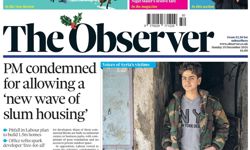Hello and thanks for starting to read this… I hope you make it through to the end. Why? Because I will feel better about myself and you might have picked up a few tips along the way.
By way of very brief introduction, I started newspaper life in a district office of the Yorkshire Post pretty much as tea boy. For the next 32 years (OMG!), I worked for a variety of regional newspapers across the country before finally succumbing to the bright lights of London working for the Evening Standard and Daily Mail. Throughout all of this time, I worked exclusively in the newspaper sales and logistics areas.
Two years ago, I joined Trinity Mirror as group newspaper sales and marketing director, adding the marketing and insight functions to my area of responsibility… and I have to say it’s been the best part of my working career. Well, actually, the best part has been the last six months when I became general manager for Mirror Group and it’s this that I’d like to tell you about.
General manager? Don’t they walk around factory floors in a beige overall with different coloured biros in their top pocket? It appears not. In a nutshell, my role is to manage the P&L for Mirror Group, both print and digitally, by either driving the top line revenue, reducing the cost base or more likely a combination of the two to hit our profit number. I still head up the newspaper sales functions, however I now have access to all parts of the company which is essentially why this is the best part of my career – and what I can now say with some authority is that we newspapers sales “dinosaurs” know a lot more than we give ourselves credit for and can make an even more significant contribution to the business than perhaps we thought. But I guess that’s fairly logical, isn’t it? Given that newspaper sales is at the end of the supply chain (ie. we get the product when every other department has had their input), then we are perhaps in the best position to understand more of how each department works given how we rely on them to complete before we can start. As a result, our tacit knowledge of the business is at a premium – so let’s use it.
So what’s going on? It’s fair to say that the news media business is challenging. Advertising revenues are under pressure and circulation volumes are declining and, unless you have ostrich-like tendencies, there have been a few legacy phone hacking issues to be dealt with – what a great backdrop against which to take on my new role! What has our response to this been? There’s a whole raft of them so let me start with a few of the revenue driving initiatives that we have initiated.
Advertisers and Agencies
We didn’t believe we had enough visibility of our teams or our brands in this arena. We changed our advertising sales function name from NASA (we sell space!!) to Trinity Mirror Solutions - after all, if you google ‘NASA’ we were never likely to be first in the search results! This was followed by a significant trade marketing drive including road shows at over twenty agencies at which we showcased the company, our audience and even held our daily editorial conference within the agency which was hugely popular.
We set up our own in-house creative agency called ‘Inventions’ to create and capture those innovative cross-media campaigns that are lucrative but labour intensive – and it’s working. We are receiving and converting more briefs and growing market share against our competitive set.
Close co-operation between editorial and commercial means that we now offer advertisers more innovative, intrusive and impactful ad formats from fireplace formats to wraparounds.
Digital Growth
We have invested in our digital sites and driven audiences hugely. We were relatively late to the digital arena but Trinity Mirror is now the 2nd biggest digital newsbrand in the UK, headed only by MailOnline (NRS PADD, April 2014-March 2015). Page views are 59% ahead of last year and digital display revenue is up by 44%. Under any circumstance, this is an impressive performance. The Mirror.co.uk strategy is: “The news you need to read, the videos you have to watch and the stories you want to share.”
Some of the factors influencing our audience growth include:
* Complete flexibility
* Move fast (more stories online more quickly)
* Be prepared to work with other platforms
* Be prepared to work in other countries
* 24/7 coverage
* And everything needs to happen now
Our e-edition has 75k active views each day which is a large, engaged and valuable audience. We now charge print advertisers an additional fee for their ad to appear in our e-edition otherwise we replace it with house inventory. This is providing very useful incremental revenue on top of the reader subscription cash that we receive.
However, there have been recent reports published that forecast by 2020, digital revenues may still only represent 30% of income, therefore print revenue remains very important.
Print Plans
At Trinity Mirror, we continue to revitalise our print products and nowhere is this more evident than in Liverpool. Put in its simplest form, we asked the people of Liverpool what they wanted the Liverpool Echo to be under the slogan #tellAli (Alastair Machray is editor). They told us and we acted with a new look Echo that is more confident, more upbeat about the city, gives readers better and more prominent information about what to do in Liverpool… and also covers Everton FC more comprehensively! It’s bold, it’s striking and we hope that this will form the blueprint for our stable of regional titles into the future.
The Daily Mirror will shortly be starting its third iteration of the ‘Intelligent Tabloid’ brand ads which have helped us to outperform our market for 37 consecutive months. This is despite the fact that our cover price is 50% higher than our competitors!
However, despite these positive aspects, we have had to continue to address our cost base, which in the first half of this year fell by £27m across the group. Here’s some of the ways we achieved this:
Cost Mitigation
In some areas, we benefit from global economic forces. For instance, newsprint prices are at a seven-year low and as our biggest raw material, this is a significant contributor in our cost mitigation drive. But there is a raft of initiatives that we have embarked upon and I challenge you to ask yourselves the questions we have asked ourselves.
* Trim Sizes: can you reduce the trim size of your newspaper, magazine or supplement by millimetres? You will be surprised by the saving it makes. Whilst you’re at it, look at the paper stock you are using. There are cheaper alternatives that are great quality in the marketplace.
* Pagination: is all of your content vital or have you always done it that way? Be more aggressive with your pagination policy and challenge what you believe your readers want to read rather than what you serve them up – it’s about quality not quantity.
* Overseas copies: if you are a newspaper that prints in Europe to meet the tourist demand, make sure that you are limiting supplies that incur high costs (eg. those that are flown from one Canary Island to another). Also, why not limit your pagination by taking out content that is unnecessary? Do tourists need to read classified ads? No? Well remove them and save newsprint.
* Logistics: can you save on logistics costs by sharing distribution routes from printer to wholesaler with one of your competitors? You will more than likely find that even your biggest rival is happy to save money by sharing with you or at least that’s our experience - after all, the battle is on the counter not on its journey there.
* Resource allocation: the depth and granularity that digital analytics provide is immense. Use them to understand the true cost of your web traffic by looking at your labour cost versus the page views that each section’s content delivers; eg. news vs sport vs fashion vs politics vs social etc. This then allows you to take out resource in areas that are simply not delivering cost effective web traffic and add resource where there are real growth opportunities.
* Integration: print and digital integration is an oft-used phrase. Is your organisation brilliant at repurposing content for different platforms or are you guilty of having the same content written by two people – one on print, the other in digital? Do your print and digital teams physically sit together to drive synergies? Get this right and you will find that you don’t need to continually hire new people to grow your digital story count and thereby your audience.
* Workspace: look at the space you work in. Inevitably you will have at least 25% of the desk space unoccupied at any given time. Can you lose some of that space by better utilisation and by introducing hot-desking and generally being more disciplined in your office design? Office space anywhere is expensive, however if you are in London, every square meter that you don’t have to pay for is a very valuable saving.
* Contributor fees: are you paying unnecessary news agency and contributor fees when you already have contracts with the major news agencies whose service is wholly acceptable? I bet you are all paying for news stories and photos that you don’t need to because your systems and processes don’t adequately monitor this. Get better control here with clear budgets for each news and features section and you will see your contribs bill tumble whilst not affecting the quality of your editorial.
* Travel: if, like us, you have companies scattered throughout the UK, you’ve probably got a major travel and expenses bill as teams come to London for head office meetings. Use video conferencing and Google Hangouts and many of those trips no longer need to be made.
* Not forgetting: and of course, sometimes it’s worth sweating the small stuff! Don’t forget colour photocopying which is about 10x more expensive than mono. Simple solutions – just remove the colour print drives from people’s computers and only have one person in each team with that colour facility. You soon find that only necessary colour copying is done. Small but perfectly formed!
In conclusion, I am loving the variety of my new role at Trinity Mirror. We are influencing revenue with new initiatives and where there are shortfalls, we are cost mitigating with a mixture of obvious, why didn’t we do this years ago, as well as some pretty innovative and smarter ways of working. It’s still tough out there but our very recent interim statement had some very positive messages and our share price grew! Good luck to you and your business – but ditch the beige overall!












